Information for management
Internal control and risk management are fundamental components of good corporate governance. Good corporate governance means that the board must identify and manage all risks for a company. To enable management to identify and manage risks and monitor internal controls within an organisation, they need adequate information flows from within the business.
Information needs
There should be effective channels of communication within the organisation, so that all managers receive timely information that is relevant to the performance of their tasks and duties.
Information should be provided regularly to management so that they can monitor performance with respect to efficiency, effectiveness in achieving targets, economy and quality.
- Managers need both internal and external information to make informed business decisions and to report externally.
- The actual information provided to management varies depending on the different levels of management.
- Different information systems are available to provide the required information.
Management levels
The information requirements of managers will vary depending on their specific role with regard to internal control and risk. Within an organisation, management are normally divided into three different levels: strategic, tactical and operational. These three levels of management, as described by Anthony, can be illustrated by the following diagram:
In general terms, each level of management will be involved in specific activities:

The two key activities of management are therefore:

The mix of the planning/risk and monitoring/internal control activities is sometimes shown in diagrammatic form as follows:
Internal control and risk management activities
The activities of the three management levels regarding internal control and risk are:
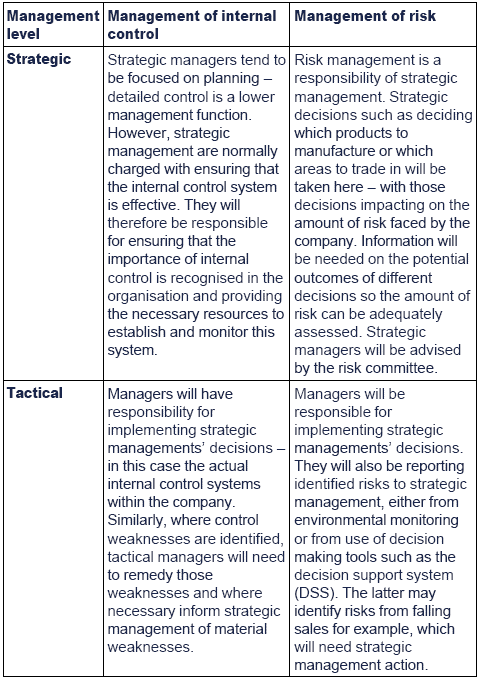
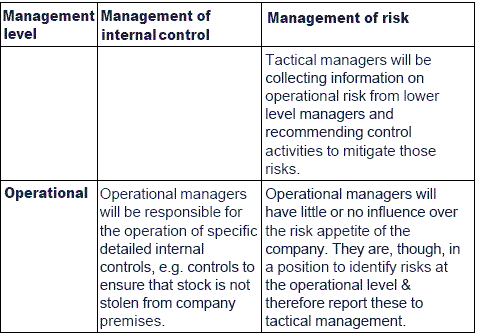
To carry out these activities, each management level will need specific information from specific information systems.
Information systems for management control
The information systems providing that information must therefore vary so that appropriate information is provided to each level of management and focused on their specific objectives regarding internal control and risk. The diagram below reiterates the management levels and indicates the general type of information system that will be provided for that management level.
Types of information system
- Executive Information System (EIS): a computer based system for total business modelling. It monitors reality and facilitates actions that improve business results.
- Management Information System (MIS): a system to convert data from internal and external sources into information, and to communicate that information in an appropriate form to managers at all levels and in all areas of the business to enable them to make timely and effective decisions.
- Decision Support System (DSS): a computer based system which enable managers to confront ill-structured problems by direct interaction with data and problem-solving programs.
- Transaction Processing System (TPS): a system that routinely captures, processes, stores and outputs low level transaction data.

Information characteristics and quality
The information received by management needs to be of a certain standard to be useful in internal control and risk management and monitoring.
There should be an adequate, integrated, information system, supplying internal financial, operational and compliance data and relevant external data.
The information should meet the criteria of 'good' information (ACCURATE):
- Accurate
- Complete
- Cost-beneficial
- User-targeted
- Relevant
- Authoritative
- Timely
- Easy to use
The characteristics of that information will change depending on the management level using that information.
The table below shows the characteristics of information and how their quality varies depending on what is made available.
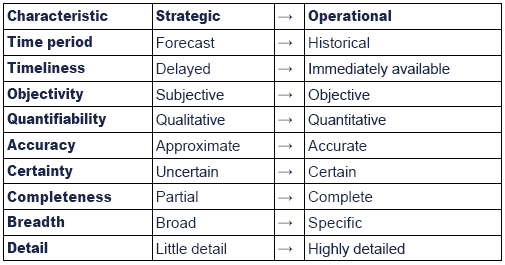
Information characteristics
Given that management activities regarding internal control and risk management are different, the characteristics of information provided by the different management information systems will also be different. Characteristics of information for these management decision areas can be summarised as shown below:
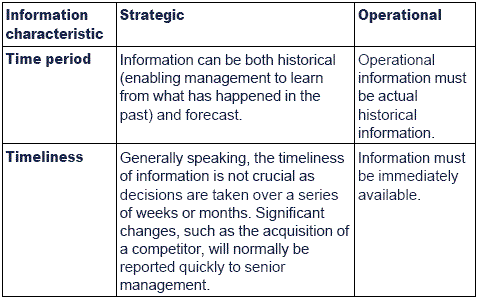

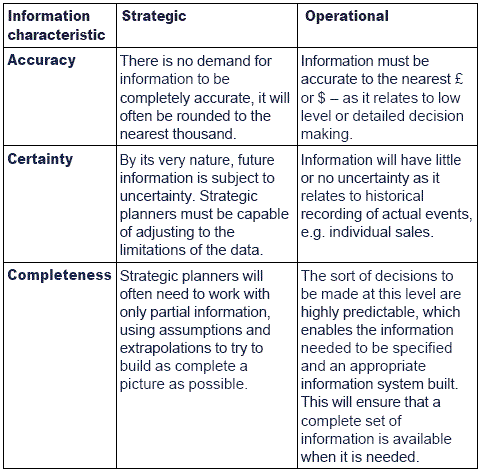
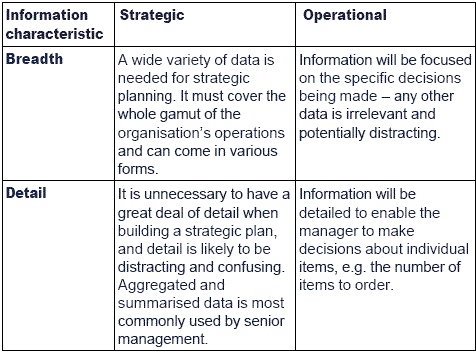
Just as tactical decision making forms a link between strategic and operational management, the information it requires has some of the characteristics of each.
Forecast and historical data are both required, although historical data is not needed as immediately as it is for operational decisions.Information is largely objective and quantitative but the greater experience of middle managers making tactical decisions makes this less important than for operational information.
For each of the other information qualities - accuracy,certainty, completeness, breadth and detail - tactical information occupies the mid-point between strategic and operational information.
|
Created at 8/20/2012 3:31 PM by System Account
(GMT) Greenwich Mean Time : Dublin, Edinburgh, Lisbon, London
|
Last modified at 9/30/2013 11:18 AM by System Account
(GMT) Greenwich Mean Time : Dublin, Edinburgh, Lisbon, London
|
|
|
|
 |
Rating
:
|
 Ratings & Comments
(Click the stars to rate the page) Ratings & Comments
(Click the stars to rate the page)
|
 |
Tags:
|
|
|
|
|